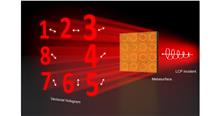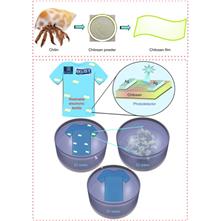 View fulltext
View fulltext
Ultra-high spectral purity lasers are of considerable research interests in numerous fields such as coherent optical communication, microwave photonics, distributed optical fiber sensing, gravitational wave detection, optical clock, and so on. Herein, to deeply purify laser spectrum with compact size under normal condition, we propose a novel and practical idea to effectively suppress the spontaneous radiation of the laser cavity through weak external distributed perturbation. Subsequently, a laser configuration consisting of a main lasing cavity and an external distributed feedback cavity is proposed. The feedback signal with continuous spatio-temporal phase transition controlled by a distributed feedback structure is injected into the main cavity, which can deeply suppress the coupling rate from the spontaneous radiation to the stimulated emission and extremely purify the laser spectrum. Eventually, an ultra-narrow linewidth on-chip laser system with a side mode suppression ratio greater than 80 dB, an output linewidth of 10 Hz, and a relative intensity noise less than -150 dB/Hz is successfully obtained under normal conditions. The proposed concept in this work provides a new perspective for extreme regulation of laser parameters by using weak external distributed perturbation, which can be valid for various gain-type lasers with wide wavelength bands.
Polarization is a basic characteristic of electromagnetic waves that conveys much optical information owing to its many states. The polarization state is manipulated and controlled for optical information security, optical encryption, and optical communication. Metasurface devices provide a new way to manipulate wave-fronts of light. A single ultrathin metasurface device can generate and modulate several differently polarized light fields, and thus carries optical information in several different channels. Terahertz (THz) waves have become widely used as carrier waves for wireless communication. Compact and functional metasurface devices are in high demand for THz elements and systems. This paper proposes a tri-layer metallic THz metasurface for multi-channel polarization generation and phase modulation with a high efficiency of approximately 80%. An azimuthally polarized THz vectorial beam generator is realized and characterized for use as a THz polarization analyzer. The incident polarization angle can be observed graphically with high accuracy. Moreover, a vectorial hologram with eight channels for different linear polarization states is demonstrated experimentally. The information in different holograms can be hidden by choosing the polarization channel for detection. This work contributes to achieving multi-functional metasurface in the THz band and can benefit THz communication and optical information security.
Disposable devices designed for single and/or multiple reliable measurements over a short duration have attracted considerable interest recently. However, these devices often use non-recyclable and non-biodegradable materials and wasteful fabrication methods. Herein, we present ZnO nanowires (NWs) based degradable high-performance UV photodetectors (PDs) on flexible chitosan substrate. Systematic investigations reveal the presented device exhibits excellent photo response, including high responsivity (55 A/W), superior specific detectivity (4x1014 jones), and the highest gain (8.5x1010) among the reported state of the art biodegradable PDs. Further, the presented PDs display excellent mechanical flexibility under wide range of bending conditions and thermal stability in the measured temperature range (5–50 °C). The biodegradability studies performed on the device, in both deionized (DI) water (pH≈6) and PBS solution (pH=7.4), show fast degradability in DI water (20 mins) as compared to PBS (48 h). These results show the potential the presented approach holds for green and cost-effective fabrication of wearable, and disposable sensing systems with reduced adverse environmental impact.
Significant progress has been made in computational imaging (CI), in which deep convolutional neural networks (CNNs) have demonstrated that sparse speckle patterns can be reconstructed. However, due to the limited “local” kernel size of the convolutional operator, for the spatially dense patterns, such as the generic face images, the performance of CNNs is limited. Here, we propose a “non-local” model, termed the Speckle-Transformer (SpT) UNet, for speckle feature extraction of generic face images. It is worth noting that the lightweight SpT UNet reveals a high efficiency and strong comparative performance with Pearson Correlation Coefficient (PCC), and structural similarity measure (SSIM) exceeding 0.989, and 0.950, respectively.












